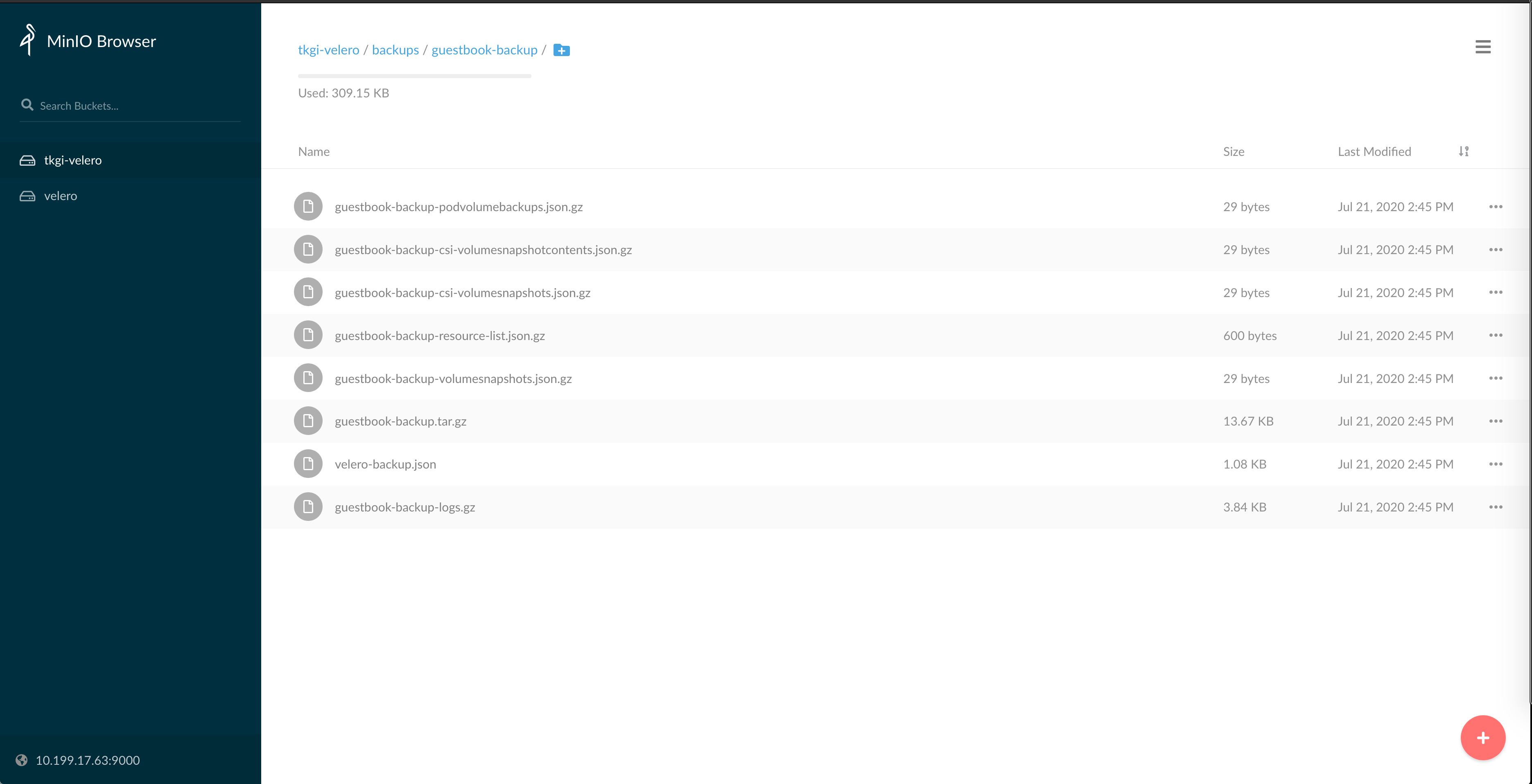This topic describes how to use Velero to back up and restore a stateless application using the namespace feature with Velero.
Overview
The application we are going to use to test back up/restore with Velero is the standard Guestbook app (stateless app).
Prerequisites
Install and configure MinIO, Velero, and restic.
Download the Guestbook app YAML files to a local known directory:
- redis-leader-deployment.yaml
- redis-leader-service.yaml
- redis-follower-deployment.yaml
- redis-follower-service.yaml
- frontend-deployment.yaml
- frontend-service.yaml
Deploy Guestbook App
Create Guestbook namespace:
kubectl create ns guestbook
namespace/guestbook created
Deploy the Guestbook app:
kubectl apply -f . -n guestbook
deployment.apps/frontend created
service/frontend created
deployment.apps/redis-leader created
service/redis-leader created
deployment.apps/redis-follower created
service/redis-follower created
root@PKS-client-VM-WA:/DATA/K8s-Apps
Verify:
kubectl get pod -n guestbook
NAME READY STATUS RESTARTS AGE
frontend-6cb7f8bd65-kqbf6 1/1 Running 0 38s
frontend-6cb7f8bd65-s7mk9 1/1 Running 0 38s
frontend-6cb7f8bd65-vtz4k 1/1 Running 0 38s
redis-leader-7b8487bf68-2mhcd 1/1 Running 0 38s
redis-follower-5bdcfd74c7-4hhqs 1/1 Running 0 37s
redis-follower-5bdcfd74c7-hl8hf 1/1 Running 0 37s
kubectl get svc -n guestbook
NAME TYPE CLUSTER-IP EXTERNAL-IP PORT(S) AGE
frontend LoadBalancer 10.100.200.3 10.199.41.10 80:32498/TCP 47s
redis-leader ClusterIP 10.100.200.192 <none> 6379/TCP 47s
redis-follower ClusterIP 10.100.200.218 <none> 6379/TCP 46s
Access the Guestbook app at http://10.199.41.10/.

Back Up the Guestbook App using Namespace
This example shows how to back up and restore the Guestbook app using the --include namespace tag.
velero backup create guestbook-backup --include-namespaces guestbook
Back up request "guestbook-backup" submitted successfully.
Run `velero backup describe guestbook-backup` or `velero backup logs guestbook-backup` for more details.
Verify:
velero backup describe guestbook-backup
Expect result:
Name: guestbook-backup
Namespace: velero
Labels: velero.io/storage-location=default
Annotations: velero.io/source-cluster-k8s-gitversion=v1.17.8+vmware.1
velero.io/source-cluster-k8s-major-version=1
velero.io/source-cluster-k8s-minor-version=17
Phase: Completed
Errors: 0
Warnings: 0
Namespaces:
Included: guestbook
Excluded: <none>
Resources:
Included: *
Excluded: <none>
Cluster-scoped: auto
Label selector: <none>
Storage Location: default
Velero-Native Snapshot PVs: auto
TTL: 720h0m0s
Hooks: <none>
Backup Format Version: 1
Started: 2020-07-21 14:45:51 -0700 PDT
Completed: 2020-07-21 14:45:52 -0700 PDT
Expiration: 2020-08-20 14:45:51 -0700 PDT
Total items to be backed up: 60
Items backed up: 60
Velero-Native Snapshots: <none included>
Verify the backup that was created.
velero backup get
NAME STATUS ERRORS WARNINGS CREATED EXPIRES STORAGE LOCATION SELECTOR
guestbook-backup Completed 0 0 2020-07-21 14:45:51 -0700 PDT 29d default <none>
Check the tkgi-velero bucket on the MinIO server.

Velero writes some metadata in Kubernetes CustomResourceDefinition (CRD).
kubectl get crd
Expected result:
NAME CREATED AT
backups.velero.io 2020-07-21T21:04:39Z
backupstoragelocations.velero.io 2020-07-21T21:04:39Z
clusterlogsinks.pksapi.io 2020-07-07T22:55:25Z
clustermetricsinks.pksapi.io 2020-07-07T22:55:26Z
deletebackuprequests.velero.io 2020-07-21T21:04:39Z
downloadrequests.velero.io 2020-07-21T21:04:39Z
loadbalancers.vmware.com 2020-07-07T22:39:04Z
logsinks.pksapi.io 2020-07-07T22:55:25Z
metricsinks.pksapi.io 2020-07-07T22:55:26Z
nsxerrors.nsx.vmware.com 2020-07-07T22:39:04Z
nsxlbmonitors.vmware.com 2020-07-07T22:39:05Z
nsxlocks.nsx.vmware.com 2020-07-07T22:39:04Z
podvolumebackups.velero.io 2020-07-21T21:04:39Z
podvolumerestores.velero.io 2020-07-21T21:04:39Z
resticrepositories.velero.io 2020-07-21T21:04:39Z
restores.velero.io 2020-07-21T21:04:39Z
schedules.velero.io 2020-07-21T21:04:40Z
serverstatusrequests.velero.io 2020-07-21T21:04:40Z
volumesnapshotlocations.velero.io 2020-07-21T21:04:40Z
The Velero CRDs let you run certain commands, such as the following:
kubectl get backups.velero.io -n velero
NAME AGE
guestbook-backup 4m58s
kubectl describe backups.velero.io guestbook-backup -n velero
Name: guestbook-backup
Namespace: velero
Labels: velero.io/storage-location=default
Annotations: velero.io/source-cluster-k8s-gitversion: v1.17.8+vmware.1
velero.io/source-cluster-k8s-major-version: 1
velero.io/source-cluster-k8s-minor-version: 17
API Version: velero.io/v1
Kind: Backup
Metadata:
Creation Timestamp: 2020-07-21T21:45:51Z
Generation: 5
Resource Version: 3355027
Self Link: /apis/velero.io/v1/namespaces/velero/backups/guestbook-backup
UID: 9d71a2c4-6fdd-42a2-963d-e85a91926dac
Spec:
Hooks:
Included Namespaces:
guestbook
Storage Location: default
Ttl: 720h0m0s
Status:
Completion Timestamp: 2020-07-21T21:45:52Z
Expiration: 2020-08-20T21:45:51Z
Format Version: 1.1.0
Phase: Completed
Progress:
Items Backed Up: 60
Total Items: 60
Start Timestamp: 2020-07-21T21:45:51Z
Version: 1
Events: <none>
Restore the Guestbook App
To test the restoration of the Guestbook app, delete it.
Delete the namespace:
kubectl delete ns guestbook
namespace "guestbook" deleted
Restore the app:
velero restore create --from-backup guestbook-backup
Restore request "guestbook-backup-20200721145620" submitted successfully.
Run `velero restore describe guestbook-backup-20200721145620` or `velero restore logs guestbook-backup-20200721145620` for more details.
Verify that the app is restored:
velero restore describe guestbook-backup-20200721145620
Name: guestbook-backup-20200721145620
Namespace: velero
Labels: <none>
Annotations: <none>
Phase: Completed
Backup: guestbook-backup
Namespaces:
Included: all namespaces found in the backup
Excluded: <none>
Resources:
Included: *
Excluded: nodes, events, events.events.k8s.io, backups.velero.io, restores.velero.io, resticrepositories.velero.io
Cluster-scoped: auto
Namespace mappings: <none>
Label selector: <none>
Restore PVs: auto
Run the following commands to verify:
velero restore get
NAME BACKUP STATUS ERRORS WARNINGS CREATED SELECTOR
guestbook-backup-20200721145620 guestbook-backup Completed 0 0 2020-07-21 14:56:20 -0700 PDT <none>
kubectl get ns
NAME STATUS AGE
default Active 13d
guestbook Active 19s
kube-node-lease Active 13d
kube-public Active 13d
kube-system Active 13d
pks-system Active 13d
velero Active 50m
kubectl get pod -n guestbook
NAME READY STATUS RESTARTS AGE
frontend-6cb7f8bd65-kqbf6 1/1 Running 0 29s
frontend-6cb7f8bd65-s7mk9 1/1 Running 0 29s
frontend-6cb7f8bd65-vtz4k 1/1 Running 0 29s
redis-leader-7b8487bf68-2mhcd 1/1 Running 0 29s
redis-follower-5bdcfd74c7-4hhqs 1/1 Running 0 29s
redis-follower-5bdcfd74c7-hl8hf 1/1 Running 0 29s
kubectl get svc -n guestbook
NAME TYPE CLUSTER-IP EXTERNAL-IP PORT(S) AGE
frontend LoadBalancer 10.100.200.127 10.199.41.14 80:32673/TCP 34s
redis-leader ClusterIP 10.100.200.78 <none> 6379/TCP 34s
redis-follower ClusterIP 10.100.200.250 <none> 6379/TCP 34s
Access the Guestbook app at http://10.199.41.14/.

Conclusions
Note the following:
- The namespace
guestbookis automatically re-created. - The IP address for the Kubernetes service load balancer is changed from
10.199.41.10to.14.